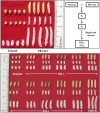Molecular mapping of QTLs for grain dimension traits in Basmati rice
- PMID: 35983411
- PMCID: PMC9379801
- DOI: 10.3389/fgene.2022.932166
Molecular mapping of QTLs for grain dimension traits in Basmati rice
Abstract
Basmati rice is known for its extra-long slender grains, exceptional kernel dimensions after cooking, high volume expansion, and strong aroma. Developing high yielding Basmati rice varieties with good cooking quality is a gigantic task. Therefore, identifying the genomic regions governing the grain and cooked kernel dimension traits is of utmost importance for its use in marker-assisted breeding. Although several QTLs governing grain dimension traits have been reported, limited attempts have been made to map QTLs for grain and cooked kernel dimension traits of Basmati rice. In the current study, a population of recombinant inbred lines (RIL) was generated from a cross of Sonasal and Pusa Basmati 1121 (PB1121). In the RIL population, there was a significant positive correlation among the length (RRL: rough rice length, MRL: milled rice length, CKL: cooked kernel length) and breadth (RRB: rough rice breadth, MRB: milled rice breadth and CKB: cooked kernel breadth) of the related traits, while there was significant negative correlation between them. QTL mapping has led to the identification of four major genomic regions governing MRL and CKL. Two QTLs co-localize with the earlier reported major gene GS3 and a QTL qGRL7.1, while the remaining two QTLs viz., qCKL3.2 (qMRL3.2) and qCKL4.1 (qMRL4.1) were novel. The QTL qCKL3.2 has been bracketed to a genomic region of 0.78 Mb between the markers RM15247 and RM15281. Annotation of this region identified 18 gene models, of which the genes predicted to encode pentatricopeptides and brassinosteroid insensitive 1-associated receptor kinase 1 precursor may be the putative candidate genes. Furthermore, we identified a novel QTL qKER2.1 governing kernel elongation ratio (KER) in Basmati rice.
Keywords: SSR markers; basmati rice; grain quality; mapping; quantitative trait loci.
Copyright © 2022 Malik, Kumar, Ellur, Krishnan S, Dixit, Bollinedi, Vinod, Nagarajan, Bhowmick, Singh and Singh.
Conflict of interest statement
The authors declare that the research was conducted in the absence of any commercial or financial relationships that could be construed as a potential conflict of interest.
Figures




References
-
- Agrawal G. K., Jwa N. S., Shibato J., Han O., Iwahashi H., Rakwal R., et al. (2003). Diverse environmental cues transiently regulate OsOPR1 of the “octadecanoid pathway” revealing its importance in rice defense/stress and development. Biochem. Biophys. Res. Commun. 310, 1073–1082. 10.1016/j.bbrc.2003.09.123 - DOI - PubMed
-
- Amarawathi Y., Singh R., Singh A. K., Singh V. P., Mohapatra T., Sharma T. R., et al. (2008). Mapping of quantitative trait loci for basmati quality traits in rice (Oryza sativa L.). Mol. Breed. 21, 49–65. 10.1007/s11032-007-9108-8 - DOI
-
- Anand D., Baunthiyal M., Gopala Krishnan S., Singh N. K., Prabhu K. V., Singh A. K., et al. (2013a). Novel InDel variation in GS3 locus and development of InDel based marker for marker assisted breeding of short grain aromatic rices. J. Plant Biochem. Biotechnol. 24, 120–127. 10.1007/s13562-013-0243-5 - DOI
-
- Anand D., Baunthiyal M., Singh A., Gopala Krishnan S., Singh N. K., Prabhu K. V., et al. (2013b). Validation of gene based marker-QTL association for grain dimension traits in rice. J. Plant Biochem. Biotechnol. 22, 467–473. 10.1007/s13562-012-0176-4 - DOI
LinkOut - more resources
Full Text Sources
Research Materials
Miscellaneous

